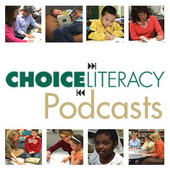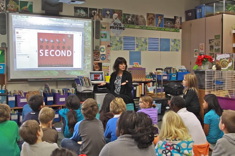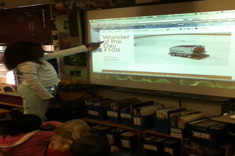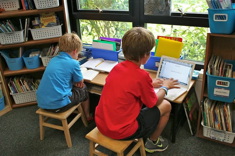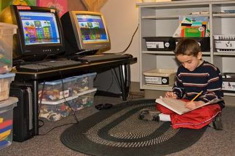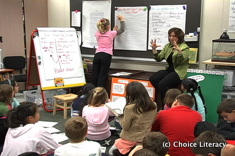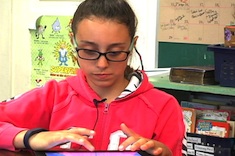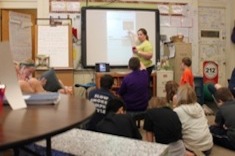Digital Literacy
Thoreau once wrote we are in danger of becoming the "tool of our tools," but it's doubtful he envisioned a day when there would be so much technology hardware and software to distract and empower us at the same time. Teachers who are grappling with iPads, laptops, kid blogs and cellphones in classrooms share their triumphs and struggles here.
Latest Content
Updating Reading Interviews: Technology and Changing Habits
Reading Interviews are a staple in many literacy programs – a terrific tool for learning more about the history and habits of students. Franki Sibberson explains how she has updated her reading interview to include questions about digital resources and tools.
5 Easy Steps to Becoming Active in the Blog Community
If you are beginning to involve yourself more in online networks, you might enjoy these suggestions from Mary Lee Hahn and Franki Sibberson.
Born Wonders: Tapping Student Interest in Animals, Babies, and Books
Cute Alert – what’s more adorable than babies or animals? Perhaps baby animals! Andrea Smith shares an addictive web resource that will instantly hook students of any age. It’s zoo postings of newborn animals from around the world, with many literacy connections.
Patrick Carman on Books and Multimedia (PODCAST)
Patrick Carman is the author of some fascinating multimedia novels for young readers.
Using Animated Short Films to Teach Inference
Here’s a problem many teachers share – students are far too literal when it comes to inferring while reading. Ellie Gilbert finds animated short films readily available on the web are a terrific tool for helping students move beyond literal interpretations of text.
Fireflies: Then and Now
Andrea Smith watches her young daughter capture fireflies in the twilight of a summer night. The evening reminds her of what’s changed in connecting literacy and life experiences, and what endures for teachers and kids.
Tech Tools for Our Youngest Learners with Kathy Cassidy (PODCAST)
Kathy Cassidy has the tips and tools of the trade for increasing technology in developmentally appropriate way for little ones.
Producing Instead of Consuming: Using iPads Wisely with Students
In order for an iPad to transform teaching and learning, Tony Keefer suggests we need to think about these tools with creativity in mind. This article is packed with thoughtful resources for iPad users.
Refining the Weekly Class Newsletter
Andrea Smith uses the school-to-home communication tool to give her writers an authentic process and audience.
Photovoice: Exploring Content Literacy with Images
As Suzy Kaback explores the question “How does your expertise function?” she explains the power of Photovoice and details its use in K-12 classrooms.
Getting Started With Twitter
Intrigue, frustration, instruction at the point of need…Franki Sibberson cycles through many common learning stages as she builds Twitter into her daily routine.
Strawberries, Fun, and Student Blogging
Andrea Smith evaluates the success of her new student blogging program.
Wonderopolis: Nonfiction, Technology, and Web-Based Independent Learning
Wonderopolis hits the sweet spot so many of us are looking for in web resources for students, delivering free, engaging, high-quality nonfiction text and video in small chunks that can easily be integrated into literacy and science workshops. Andrea Smith explains how she uses Wonderopolis daily with her students.
Digital Handouts: An Alternative to More Paper and Meetings
Jill Ostrow creates a flexible and practical online tool to support teachers of English language learners.
Teaching Blogging to Second Graders
You’re never too young to blog, as Katie DiCesare demonstrates with her 2nd graders.
Reading Preferences: Social, Pleasurable, and Sometimes Awkward
Karen Terlecky connects an honest appraisal of her reading habits with an unvarnished look at her 5th grade students.
Redesigning a Classroom: Putting Students First (and Technology in Its Place)
Mandy Robek faces the challenge of creating a warm and inviting classroom environment that still includes some cold, hard computers for student use.
Unexpected Gifts: Technology and Community in the First Days of School
Andrea Smith is surprised and delighted at what technology adds to her classroom in the early days of school.
A District Film Festival: Giving Kids An Authentic Audience for Their Work
Lights, cameras, and even a red carpet! Bill Bass documents how a film festival brought high school teachers and students together, with a strong focus on connecting district goals and standards to the fun projects.
5 Easy Steps for Starting a Blog
Mary Lee Hahn and Franki Sibberson share tips for launching and maintaining a blog, as well as a wealth of reasons why it’s a valuable use of your time
Addicted to Twitter: How Did It Happen?
Franki Sibberson documents the stages of tweetage, from avoidance to addiction.
The Reading Skills We Use When Searching the Internet
Browsing and previewing skills change when the medium is the Internet. Franki Sibberson has advice for working with tech-savvy young readers.
Expanding the Ways We Preview Books
Franki Sibberson discovers new ways technology can expand and enrich how students preview books.
Twitter Me This: Using Cell Phones to Build Literacy Skills and a Reading Community
Lisa Koch found herself a bit irritated as her high school students would discreetly send text messages as she tried to teach them literary terms. Her solution? Tweet tweet! You can read here about her successful summer experiment of tweeting literary terms and staying in touch with students over summer reading assignments.
From Page to Screen: My Top Ten Film Adaptations of Children’s Books
Shari Frost is inspired to create a list of her favorite children’s book to film adaptations.
Panels and Pages: Using Graphic Novels in the High School Classroom
Gretchen Schroeder bolsters her students’ reading lives and deepens discussion about theme by using the rich graphic novel They Called Us Enemy as a whole-class read with her high school students. Gretchen shows how teachers can support students in deep literary analysis.
Photo Booth and Young Readers
Stella Villalba uses the Photo Booth app to build stamina in a young English language learner, as well as reinforce the learning and practice at home.
Using 9/11 Research to Build Community and Writing Process
Katherine Sokolowski gives space for students to research and share their learning about 9/11 in order to build a community of writers, as well as nourish the research and writing process.
Browse Content By
Type
Category
- Assessment Tools
- Big Fresh Archives
- Booklists
- Choice Numeracy
- Classroom Design
- Common Core
- Community Building
- Conferring
- Content Literacy
- Digital Literacy
- English Language Learners
- Equity
- Family Relations
- Free Samples
- Guiding Groups
- Leadership
- Literacy Coaches
- Mentor Texts
- Minilessons
- New Teacher Mentors
- Podcasts
- Poetry
- Quote Collections
- Reading Strategies
- Self Care
- Struggling and Striving Learners
- Talking and Listening
- Teacher Study Groups
- Teaching Reading
- Teaching Writing
- Word Study and Vocabulary
Author
- Melissa Quimby
- Nawal Qarooni
- Gwen Blumberg
- Julie Cox
- The Lead Learners
- Hannah Tills
- Josie Stewart
- Ruth Metcalfe
- Mallory Messenger
- Becca Burk
- Jodie Bailey
- Vivian Chen
- Mary Brower
- Tiffany Abbott Fuller
- Stephanie Affinito
- Ruth Ayres
- Leigh Anne Eck
- Heather Fisher
- Shari Frost
- Julie Johnson
- Suzy Kaback
- Gigi McAllister
- Shirl McPhillips
- Melanie Meehan
- Cathy Mere
- Debbie Miller
- Tara Barnett and Kate Mills
- Tammy Mulligan
- Dana Murphy
- Bitsy Parks
- David Pittman
- Brenda Power
- Heather Rader
- Matt Renwick
- Mandy Robek
- Christy Rush-Levine
- Gretchen Schroeder
- Jen Schwanke
- Brian Sepe
- Katherine Sokolowski
- Stella Villalba
- Jennifer Vincent
Grade Level
Choice Literacy Membership
Articles
Get full access to all Choice Literacy article content
Videos
Get full access to all Choice Literacy video content
Courses
Access Choice Literacy course curriculum and training




